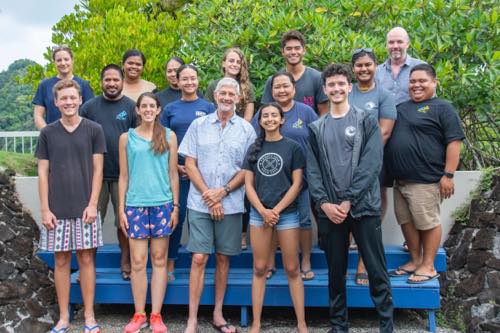- Research
Coral larvae to stay local, finds new PICRC Study
Researchers from the Palau International Coral Reef Center (PICRC), Hopkins Marine Station of Stanford University have completed genetic work on tabletop coral from 39 patch reefs across Palau to reveal how far coral larvae travel from their original reef. This work, which has implications for coral reef management, was recently published in Evolutionary Applications. The researchers included Victor Nestor and Dr. Yimnang Golbuu from PICRC and Dr. Stephen Palumbi, Dr. Nia Walker, Erik Hanson, Katrina Armstrong, Marilla Lippert, and Dr. Brendan Cornwell from Hopkins Marine Station of Stanford University. The paper is titled “Small-scale genetic structure of coral populations in Palau based on whole mitochondrial genomes: Implications for future coral resilience”.
“Restoring coral reefs is an increasingly important strategy used to combat the impacts of climate change,” said author Dr. Yimnang Golbuu, CEO of PICRC. “This strategy may be best achieved by adding resilient individuals, say those whose genetics are better suited to warmer waters, to a population.” However, he added, determining how connected reefs in close proximity are, i.e., those less than 60km apart, is important as it would indicate whether the larvae from the resilient coral would accumulate on their original reef, spread between neighboring populations, or be dispersed throughout the Pacific.
This recent work, which involved sequencing part of the genomes of 284 tabletop corals across the 39 patch reefs, found higher-than-expected larvae retention on them than models on larvae movement had predicted. These patch reefs were between 1 and 55km apart. This means that coral larvae are more likely than previously thought to stay local, settling and growing on their original or a neighboring reef. These results may go on to help determine whether local decisions, such as adding certain individuals to a population, will help increase resilience to a changing ocean.
Even if most coral larvae stay close to home, some might be longer-distance travellers. To see this, the researchers compared the Palau genomes to similar research from American Samoa, 6000 km away. They found, as expected for such distant places, that most reefs in American Samoa had tabletop corals with a different genetic fingerprint than those in Palau. However, they did find three separate groups that were identical between the two locations – sharing a long gene that mother corals passed along intact to their larvae. This means that larvae must occasionally drift across the Pacific, from Palau to America Samoa and vice versa, taking their maternally inherited genes with them. Although this is only a small amount by management standards, it is interesting as an example of the Pacific voyaging capacity of a few coral larvae.
According to the lead author of the study, Professor Stephen Palumbi, “Palau’s history of ocean conservation makes it an ideal place to study how coral reefs function, and to see how future conservation efforts can help blunt the impact of climate change.”



